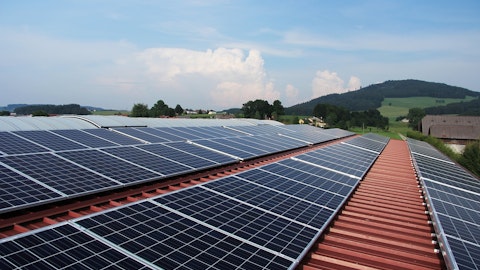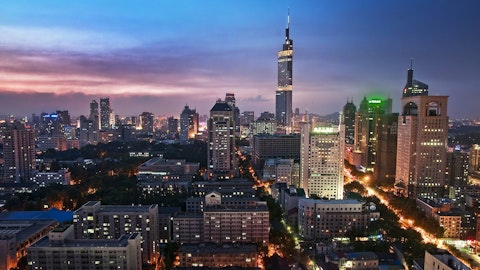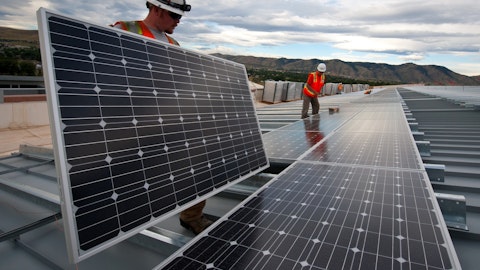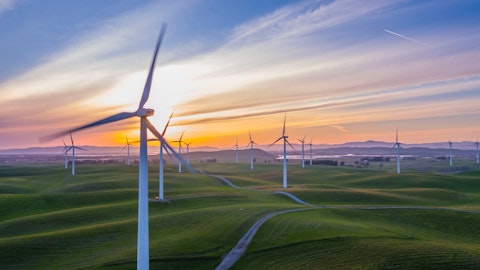Daqo New Energy Corp. (NYSE:DQ) Q4 2022 Earnings Call Transcript February 28, 2023
Operator: Good day, and welcome to the Daqo New Energy Fourth Quarter and Fiscal Year 2022 Results Conference Call. All participants will be in a listen-only-mode. Please also note today’s event is being recorded. And at this time, I would like to turn the conference call over to Kevin He, Investor Relations. Please go ahead.
Kevin He: Hello, everyone. I’m Kevin He, the Investor Relations of Daqo New Energy. Thank you for joining our conference call today. The Company just issued its financial results for the fourth quarter and fiscal year of 2022, which can be found on our website at www.dqsolar.com. To facilitate today’s conference call, we have also prepared a PPT presentation for your reference. You can also find a PPT presentation at our website. Today, attending the conference call, we have Mr. Ming Yang, our Chief Financial Officer; and Mr. Longgen, our Chief Executive Officer; and myself. So today, I will read — so before we begin, the formal remarks, I would like to remind you that certain statements on today’s call, excluding expected future operational and financial performance and industry growth are forward-looking statements that are made under the Safe Harbor provisions of the U.S. Private Securities Litigation Reform Act of 1995.
These statements involve inherent risks and uncertainties. A number of factors could cause actual results to differ materially from those contained in any forward-looking statements. Further information regarding these and other risks is included in the reports or documents we have filed with or furnished to the Securities and Exchange Commission. These statements only reflect our current and preliminary view as of today and may be subject to change. Our ability to achieve these projections is subject to risks and uncertainties. All information provided in today’s conference call is as of today, and we undertake no duty to update such information, except as required under applicable law. Also during the call, we will occasionally reference monetary amounts in U.S. dollar terms.
Please keep in mind that our functional currency is the Chinese RMB. We offer these translations into U.S. dollars solely for the convenience of the audience. Without further ado, now I will turn the call to our CEO, Mr. Zhang.
Longgen Zhang: Thank you, Kevin. Good evening, everyone. We are very pleased to report a second — to report a record result for the year 2022. We would like to thank our entire team for achieving such a strong financial and operational performance. Our annual polysilicon production volume 33,812 metric ton in 2022, exceeding our guidance of 130,000 to 132,000 metric ton and a 54.5% higher than the 86,587 metric ton produced in 2021. Our sales volume was 132,909 metric ton in 2022, 76.4% higher than 75,356 metric ton in 2021. Thanks to the robust demand for solar PV products globally, polysilicon ASPs increased by approximately 50% year-over-year from $21.76 per kg in 2021 to $32.54 per kg in 2022.As one of the most profitable and fastest-growing polysilicon manufacturers in the world.
We achieved a strong financial results with revenue of $4.61 billion in 2022, an increase of 175% compared to US$1.68 billion in 2021. Gross margin improved to 74.0% in 2022 from 65.4% in 2021, and net income attributable to our shareholders was US$1.86 billion in 2022, an increase of 148.4% compared to US$749 million in 2021. We generated approximately $2.47 billion in operating cash flow for the year, and ended the year with a very strong balance sheet with $4.65 billion in combined cash, cash equivalents, restricted cash and bank notes with maturity within 6months. For the year of 2022, approximately 99% of our production volume was mono-grade polysilicon. We continue to be one of the world’s leading suppliers of ultra-high purity N-type mono polysilicon, the foundation for next-generation N type solar cell technology.
Towards the end of 2022, a temporary seasonal slowdown in solar PV market caused inventory adjustments across the value chain, similar to the year-end of 2021. As a result, the downstream sectors, especially wafer, cell and module manufacturers, reduced inventories and significantly lowered production utilization rates. This led to widespread price declines across the value chain. In February 2023, lower module prices effectively stimulated market demand, and downstream production utilization rates quickly ramped up back to normal levels, reducing channel inventory significantly and leading to a meaningful recovery of polysilicon ASPs. Current polysilicon prices of approximately RMB230 to RMB250 per kg are very healthy and reflect the strong demand for solar modules in the range of RMB1.7 to RMB1.8 per watt.
Global solar PV installations were approximately 268 gigawatt in 2022, a 53% annual increase from approximately 175 gigawatt in 2021, growing faster than most had forecasted at the beginning of the year. The increase in polysilicon supply, in conjunction with supportive global climate change policies as well as favorable economic conditions driven by grid-parity, made 2022 one of the industry’s fastest growing years. Meanwhile, solar module price increased from approximately RMB1.8 per watt in Q1 2022 to RMB2 per watt in Q4 2022. Despite higher solar module market pricing that many expected would lead to a slowdown in China’s PV installations, the Chinese PV end-market also saw robust growth for the year, with installations of 87 gigawatt, an increase of 59% compared to 2021.
These market conditions suggest that the global PV market demand was actually limited by supply, specifically of polysilicon. Key global trends, including the urgent need to address climate change, the drive for greater energy independence as well as positive economic conditions driven by grid-parity, have led to strong demand momentum for renewable energies, including solar PV. We believe energy transformation is still in its early stage and has opened a huge potential market for solar PV, which is likely to be far beyond expectations. The high-purity polysilicon sector will continue to benefit strongly from these positive developments. Daqo New Energy is well-positioned to benefit from the above trends and deliver continued growth. The construction of our Phase 5A 100,000 metric ton polysilicon capacity expansion project in Inner Mongolia is progressing smoothly.
We expect to complete construction and start pilot production in April 2023 and ramp up to full capacity by the end of June 2023. Therefore, we expect to produce approximately 190,000 to 195,000 metric ton of polysilicon in 2023, 38% to 46% more than in 2022. Furthermore, our Phase 5B project for an additional 100,000 metric polysilicon in Inner Mongolia will start construction in March and is expected to be completed by the end of this year. Solar PV will continue to play a critical role in transforming the global energy infrastructure by powering the world with sustainable, cost-effective and renewable energies at a pace much faster than thought possible. As a leading player in polysilicon industry, we outperformed most of our peers in terms of unit profitability, cost structure, and product quality in 2022.
We believe our focus on our core competitiveness, solid growth road-map, and our strong balance sheet will allow us to benefit from the long-term growth of the global solar PV market. For the future outlook and guidance, we expect to produce approximately 31,000 metric tons to 32,000 metric tons of polysilicon in the first quarter of 2023 and approximately 190,000 metric tons to 195,000 metric tons of polysilicon in the fourth year of 2023, inclusive of the impact of the company’s annual facility maintenance. Now I will turn the call to our CFO, Mr. Yang, please.
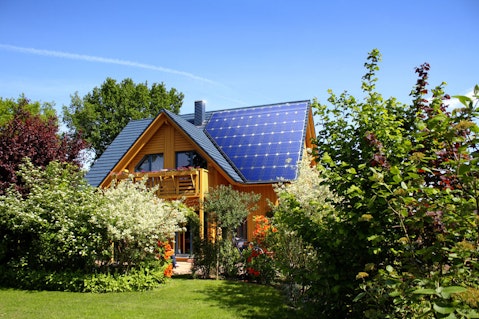
Copyright: lassedesignen / 123RF Stock Photo
Ming Yang: Thank you, Longgen, and hello, everyone. Thank you for joining our earnings conference call today. Now I will discuss the company’s financial performance for the quarter and for the year. Revenues were $864 million compared to $1.22 billion in the third quarter of 2022 and $295.5 million in the fourth quarter of 2021. The decreasing revenue compared to the third quarter of 2022 as Longgen mentioned was primarily due to a decrease in sales volume mitigated by an increase in average selling price. Gross profit for the quarter was $668.9 million, compared to $978.6 million in the third quarter of 2022 and $239.8 million in the fourth quarter of 2021. Gross margin was 77.4% compared to 80.2% in the third quarter of 2022 and 60.6% in the fourth quarter of 2021.
The slight decrease in gross profit compared to the third quarter was primarily due to lower sales volume as well as higher production costs. Sales, general and administrative expense was $44 million, compared to $280 million in the third quarter of 2022 and $10.2 million in the fourth quarter of 2021. SG&A expenses during the fourth quarter included $28.4 million in noncash share-based compensation costs related to the company’s share incentive plan. And this compares to the third quarter cost of $263.4 million in the third quarter of ’22 of noncash share-based compensation costs. Research and development expense for the quarter was $2.7 million, compared to $2.5 million in the third quarter of 2022 and $1.3 million in the fourth quarter of 2021.
R&D expenses vary from period to period reflect R&D activities that take place during the quarter. Currently, most of our R&D are spent primarily on our entire technology research as well as research to reduce production costs. Income from operations was $623 million, compared to $693 million in the third quarter of 2022 and $228 million in the fourth quarter of 2021. Operating margin was 72% compared to 56.8% in the third quarter of 2022 and 57.7% in the fourth quarter of 2021. As a result of the above, net income attributable to Daqo New Energy Corp shareholders was $372.9 million, compared to $223.4 million in the third quarter of 2022, a 1.13 million in the fourth quarter of 2021. Earnings per basic ADS was $4.78 compared to $4.28 in the third quarter of 2022, a $1.90 in the fourth quarter of 2021.
Adjusted net income attributable to Daqo New Energy shareholder, excluding noncash share-based compensation costs was $403.3 million compared to $590.4 million in the third quarter of 2022 and $143.6 million in the fourth quarter of 2021. Adjusted earnings per basic ADS was $5.17 compared to $7.81 in the third quarter of 2022 and $1.93 in the fourth quarter of 2021. EBITDA for the quarter was $648.5 million, compared to $720 million in the third quarter of 2022 and $251.1 million in the fourth quarter of 2021. EBITDA margin was 75% compared to 59% in the third quarter of 2022 and 63.5% in the fourth quarter of 2021. Now for a review of our full year 2022 results. Revenue for the year 2022 were $4.6 billion, compared to $1.68 billion in 2021.
The increase was due to higher polysilicon average selling prices saw a significantly higher . Gross profit was $3.4 billion compared to $1.1 billion in 2021. Gross margin for the year was 74% compared to 65.4% in 2021. The increase in gross profit was due to higher sales volume and higher selling prices. SG&A expenses for the year was $354.1 million compared to $39.9 million in 2021. The increase of SG&A expenses for 2022 compared to 2021 was primarily due to our noncash share-based compensation costs related to our shared incentive plan, which was $299 million for 2022, compared to $8.4 million in 2021. R&D expenses were $10 million compared to $6.5 million in 2021. Income from operations for the year was $3.04 billion, compared to $1.05 billion in 2021.
Operating margin was 66% compared to 62.6% in 2021. Interest income for the year was $14.5 million, compared to $24.5 million in net interest expense in 2021. The interest — increasing interest income was due to our higher cash balance. Income tax expense for the year was $537 million, compared to $170 million in 2021. The net income attributable to Daqo New Energy shareholders for the year was $1.86 billion, compared to $748.9 million in 2021. Earnings for basic ADS for the year was $24.51 compared to $10.14 in 2021. Adjusted net income attributable to Daqo New Energy shareholders was $2.16 billion, compared to $759 million in 2021. Adjusted earnings per basic ADS were $28.50 per share compared to $10.28 in 2021. EBITDA for the year was $2.15 billion, compared to $1.13 billion in 2021.
EBITDA margin for the year was 68.4% compared to 67.5% in 2021. And now on the Company’s financial condition. As of December 31, 2022, the company has $3.52 billion in cash, cash equivalent and restricted cash compared to $2.05 billion as of September 30, 2022 and $724 million as of December 31, 2021. And as of December 31, 2022, a bank note receivable balance, which can be immediately redeemed for cash was $1.1 billion, compared to $1.57 billion as of September 30, 20.2, and $386 million as of December 31, 2021. The bank notes typically was maturing about 6 months timeframe. And now on to the Company’s cash flow. For the 12 months ended December 31, 2022, net cash provided by operating activities was $2.46 billion, compared to $639 million the same period of 2022.
The increase was primarily due to higher revenue and higher gross margin. And for the 12 months ended December 31, 2022, net cash used in investing activity was $1 billion, compared to $782 million in the same period of 2021. Net cash used in investing activities in 2022 was primarily related to total capital expenditures on the company’s 100,000 metric ton polysilicon project in Baotou City, Inner Mongolia. And the for the 12 months ended December 31, 2022, net cash provided by financing activity was $1.47 billion, compared to $736 million in the same period of 2021. The net cash provided by finance activities in 2022 was primarily related to net proceeds of $1.6 billion from our Xinjiang Daqo’s private offering in China’s A share market.
And that concludes our prepared remarks and now we will open the call for questions from the audience.
See also 11 Most Profitable Canadian Stocks and 25 Best Countries for Solo Female Travelers .
Q&A Session
Follow Daqo New Energy Corp (NYSE:DQ)
Follow Daqo New Energy Corp (NYSE:DQ)
Operator: Our first question today comes from Philip Shen from ROTH MKM. Please go ahead with your question.
Philip Shen: Hi, everyone. Thanks for taking my questions. Wanted to start off with your latest drive on pricing. So specifically, Longgen, I think you talked about rise of modular prices stabilizing, polysilicon prices . How do you expect polysilicon prices trend by quarter for the rest of the year? Thanks.
Longgen Zhang: Thank you, Philip. I think since the last year, December, that’s every year, I think, since the year 2020 and because all the fees is Thanksgiving holiday, New Year, plus Chinese New Year, so the downstream is a waiver, I think producer of every year reduce their utility capacity. Utilization rates we call. So last year, same things happened. because Chinese New Year very close to I think the New Year. So basically, in December, last year December, we didn’t sell any silicon, 1 per kg silicon. The reason is because I think the player, player, almost the utilization expected down to, I think it’s something to zero, even 10% and clean all the inventory. So basically, then Chinese New Year is coming, I think early February.
So January, we also didn’t selling anything. So February, we’re starting, I think, whenever we — its — at the end of last year, we have inventory around 5,200 tons. So we believe I think we’ve given guidance. I think right now, the price, I think come back from last year, December, almost lower — as lower as like RMB1.8 per kg. Right now it come back to normal RMB210 to RMB250 per kg. So we sold I think more than 10,000 tons in February, as the price is higher. So we will continue selling. So we believe I think Q1, the selling price should be above RMB220. The reason is because I think in the second quarter of this year it’s not too much new player coming. So it’s not too much output, new output to come out. So we think we’ll continue to digest or even tolerate come to normal.
So my forecast, I think before mid of this year, before end of June, the selling price should be about RMB210, even higher to RMB250. For the Q3, I think the only new capacity come from our Mongolia Phase 1 , as the market demand is continued go up. So we believe I think we can keep the silicon price between 150 to 200. Q4, definitely, I think, the picture is not clear. It’s like crystal ball. So the silicon price, maybe even go down to 100 to 120. So overall, this year, we’re still thinking of very profitable for Daqo. Second is we do not think the model price will continue to go down, because we see that high performance module like module, even today in Canada, we can sell at RMB1 or RMB2 per watt. And overseas OUR costs depend on different region.
I think original almost 80% overseas they fixed the price. So it’s a very profitable. And yes, maybe the module price will go down in Q4 this year. But doesn’t matter. If — let’s say if the module price is $1.70 per watt, you can support polysilicon price above 200. So the only thing is the gross margin allocation between the silicon, wafer and the sales of module. But we believe silicon segment still is very, I think capital intensive investment, long-term constructing period, still is a challenge, yes. And I think maybe next year, then — I think it’s not only silicon, maybe all the supply and demand, but also wafer cell module the same. So, maybe come back and see the lowest module price will stimulate the whole market to come back. So I think it’s sort of .
So what I can say is this year polysilicon is very profitable. And we will continue to make money.
